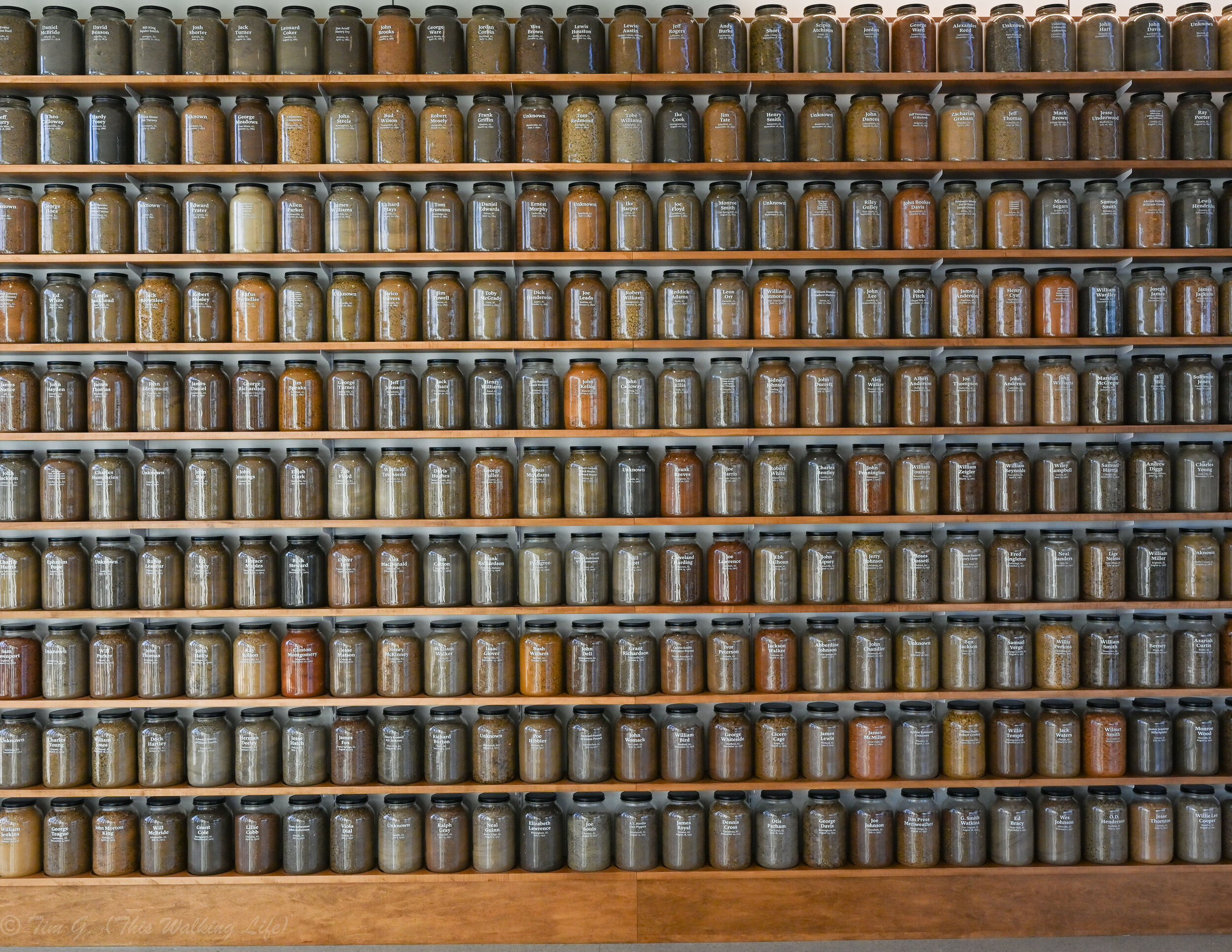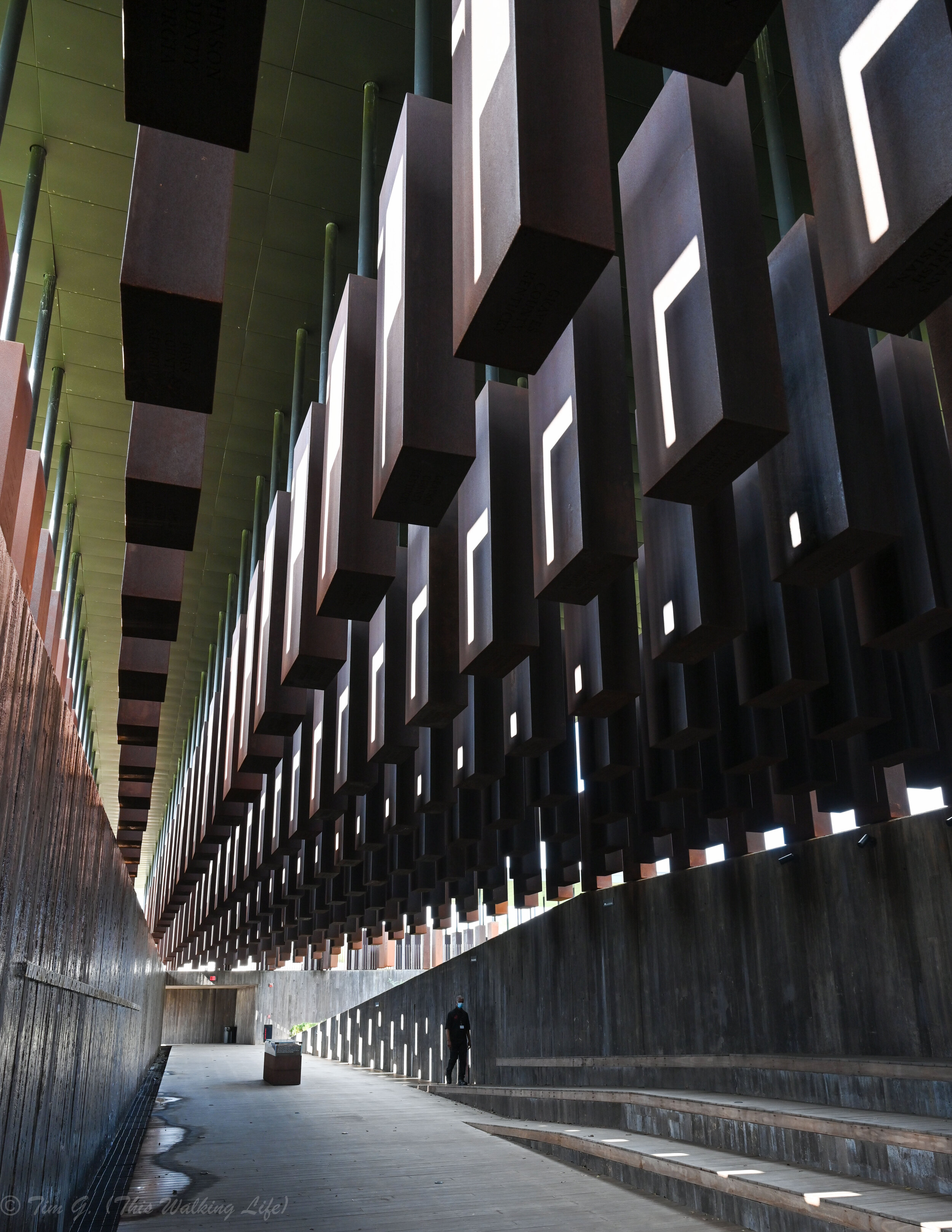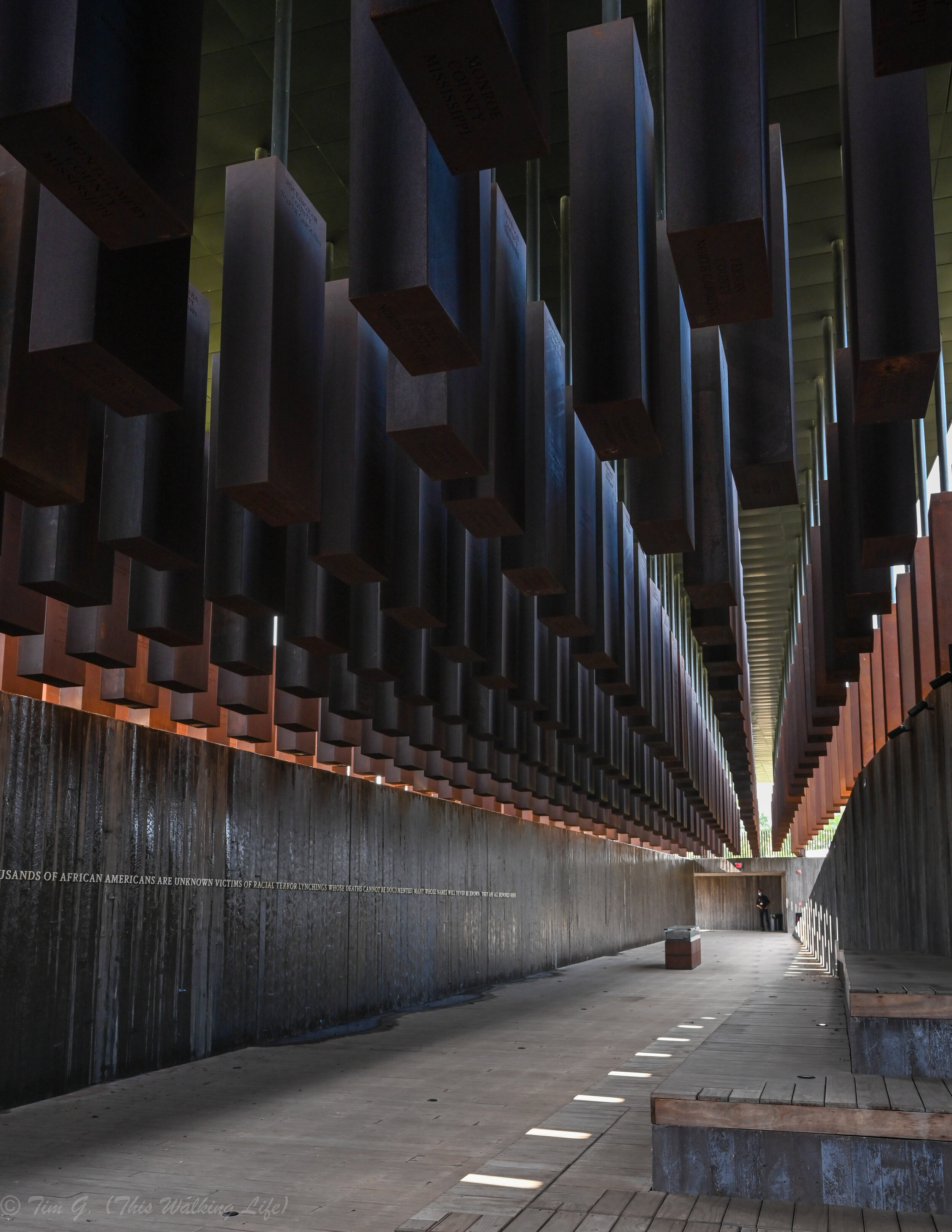“The past is never dead. It’s not even past.” William Faulkner
In the wake of everything that’s happened in 2020, especially the murder of George Floyd, which occurred just miles from my home, I’ve come to see how little I actually understand about race and politics in America. This realization has impelled me east and south this fall in order to see our country’s most famous civil war and civil rights sites with my own eyes: Gettysburg, an Underground Railroad Station, Little Rock Central High, the spot where Rosa Parks refused to stand, The Birmingham Baptist Church, the Edmund Pettus Bridge in Selma, the Ole Miss Lyceum, and the Lorraine Hotel in Memphis where MLK Jr was killed to name a few.
While I knew many of the places I wanted to visit before I left, whenever I travel, I’ll always ask the people I meet along the way for suggestions. And throughout the past few weeks, I’ve frequently been pointed toward a place I’d never heard of before: a museum and memorial created by Bryan Stevenson’s (who wrote Just Mercy), called the National Memorial for Peace and Justice in Montgomery, Alabama.
I finally got to visit yesterday.
As I entered the main building, the voice of a completely bald elderly Black man in tortoiseshell-rimmed glasses and one of those disposable blue masks politely called out to me from fifty feet away: “Hold on a minute young man”.
I stopped, and awkwardly fumbled with my phone as he approached. Of course, he needs to see my tickets, I thought. But no. “I need to take your temperature,” he told me as he pointed a handheld thermometer at my forehead. It beeped. He told me I was good.
As I continued to fumble with my phone he reassured me: “You don’t need tickets here. Only at the memorial” he pointed out of the front door, “across the street.”
However, by then, I’d already pulled my tickets up. I sheepishly asked if he’d be willing to double check them so I wouldn’t have to come back if I’d done something wrong. He tilted his head down, peered over his glasses resting on the end of his nose, and asked me to make my screen bigger.
As we both looked down my eyes caught the name on the back of his badge: Stanley. A moment later, he told me the tickets looked fine.
I thanked Stanley and turned to go, but stopped, not sure why, and haltingly asked: “Wait. There’s nothing worth seeing in here. Is there?”
“Well…” he paused and looked at me. “You’ve already been to the museum this morning. Correct?”
I had. (The memorial is a 5 minute drive from the Legacy Museum in downtown Montgomery and I’d already gone there first).
Stanley went on: “In the theater they play clips you’ve already seen in the museum. So, no need for you to see that. But…” he paused again. “We have ALL the soil from Alabama here.”
I didn’t follow what he meant.
He made a gesture to a wall behind him and started ambling slowly toward it, knowing I’d follow before he even asked.
There, I saw 10 neat rows of clear jars pressed one next to the other, stretching at least 10 feet in the air and many times that across. It seemed like each jar was a slightly different color – dark and light grays, browns, oranges, maroons, and yellows too. Who knew the earth had so many textures and hues? I thought, not yet realizing what was inside.
"These are all just from Alabama" he told me. "296 of them."
Now in front of the wall, I could see in white block letters on each jar were a few words: a name, a location, a date.
"Each jar is filled with soil from the spot of a known lynching."
In rapid fire, he pointed to a series of different jars, "We have individuals, husbands and a wives, father and sons, whole families too.”
“Two hundred and ninety-six lynchings of men, women, and children here in Alabama. And this isn’t even all of them. It’s just the ones we have documentation for.”
I was speechless.
In the void he went on: "After they died their people weren’t allowed to bury them. Sometimes they were burnt to ashes. Sometimes they were left up as a reminder. Don’t step out of line or you know what’ll happen. There are newspaper stories – we have them – they write proudly about how fingers were cut off the people hanging, sometimes while they were still alive, and handed out as souvenirs to crowds.”
There’s a photo at the museum, in it you see thousands of white folks in their Sunday best packed into a town square to watch a lynching. It’d been advertised in the paper for days before. The atmosphere looks carnivalesque. You can see food concessions in the background. A second close-up shows fathers and sons smiling beside a hanging corpse.
"These people were never buried." he repeated, "They never got closure. The idea was to collect the soil where these lynchings happened. To maybe capture some piece of their DNA, or at least the soil it’s in, and bring it here, where they could be honored and remembered. To bring them here, where it’s safe and they can rest in peace, finally."
I didn’t know where to place my eyes. I didn’t know what to say.
Stupidly I grasped for something positive or redemptive, but all I could come up was: "how did lynchings end in the 1940s?"
He arched his eyebrows: “Did they? There were plenty in the 1950s. Lots of civil rights workers murdered in the 1960s. We have an exhibit on that in the front. Did you know there was a lynching in Alabama in 1981? Did you know…?” he went on, but for a moment, I couldn’t hear him anymore. All I could think about was my own city of Minneapolis, far away from the south, and the now famous video of George Floyd: “I can’t breathe. I can’t breathe.”
When I came back to awareness, I heard him say: “It’s not the same of course. And it’s also the same. Now they put boys on death row or lock of them away forever."
We stood in silence again for a long time.
"What’s it like to be here … with them?” now it’s my turn to gesture widely, “Every day."
“Somber.” He paused: “Really somber."
Stanley pointed up to a jar with word “unknown” written three times above “Selma, AL”.
"Everyone one of these jars has a story. Everyone one of these jars was a life, sometimes many lives. This one here, this one has been calling to me a lot lately when I come in the morning. Selma is a small town; everyone knows everyone. They couldn’t be unknown unless they were just passing through. Imagine that, you are traveling with your family, and suddenly you are snatched and killed, for god knows what, and no one even writes down your name.”
After another long pause he adds: "I look at these jars and I wonder, are there any remains here of my people? We talk about this all at a high level in schools, but we don’t talk about the belly of the beast. We don’t talk about this." He gestured to the jars again. "So, yea, it's real somber.”
“Is it hard to be here with them every day? How do you take it all in?”
“You can’t take it all in. Especially not at first. I remember going through the museum the first time, and after a point I just had to leave. I couldn’t take any more in. I’ve had to go back many times. I had to force myself. Each time I see something new.”
Again, we stand in silence looking at the wall of lives stolen.
“How’d you find out about this place? How’d you decide to work here?”
“Mr. Stevenson (the founder of the EJI project).”
He turned and looked at me for the first time for more than a second. “Mr. Stevenson saved my life.”
“I was in prison.” Stanley went on, “I had a life sentence. I’d spent years honing my understanding of the law, trying to appeal my case. I even went to the Alabama Supreme Court. When I heard about what Mr. Stevenson was doing with death row inmates I wrote to him and told him life in prison is a death sentence too. He wrote me back. He asked for my files. He sent a lawyer to be with me and help me. He saved my life.”
Again, more silence.
“It’s right that you are the one to watch over this soil” I finally told him. He nodded.
He asked me where I was from. We talked a long time about Minnesota and my reactions to the museum in the morning, before I asked him one last question:
“What do you hope people will take away from seeing this?”
Stanley paused and thought: “I don’t want them to say I’m sorry.”
He looked at me pointedly. “That’s unreasonable. What I really want is for them to know what actually happened. I want them to say aloud what happened. I don’t blame you for what your great-great-grandfather did.” Again, he gestured across the wall of lives. “But his choices live in you. This history lives in us all, even if you didn’t know it before. And --”
Mid-sentence, he was interrupted. Another security guard was calling over to him. A large group of people were waiting at the door. They needed to get their temperatures taken. Now rushed, he ambled away.
When I saw he wouldn’t be able to come back soon, I left, turning over everything he said in my mind again and again as I walked the actual memorial across the street – a massive monument contained in a square pavilion. Hanging from the roof of the structure are row after row of large stones tablets (see two sides of it below). Each stone tablet is engraved with the name of a county, and underneath that are the names and dates of every documented lynching that occurred there during the Jim Crow era. There were tablets from every county in the south and quite a few from the north as well, more than 800 in all.
When you enter you are at eye level with the tablets. You can walk right up to them touch them. There were so many names, thousands, literally.
As you continue you through, the floor slants down while the tablets remain hung up. Before you know it, you are under them, looking up at row after row of hanging tablets.
And that’s when it hits you… it’s not just an orderly memorial to name the victims of racial terror, it’s a simulacrum of lynched bodies.
Below some of the stones were inscriptions with the justifications that were given by locals at the time for committing the lynchings. They felt no compunction about writing these things in papers at the time. Here were just a few:
· Robert Mallard was lynched in Lyons Georgia in 1948 for voting.
· Mack Brown was lynched for kissing a white woman on the hand
· Lacy Mitchell was lynched for testifying against a white man accused of raping black girls
· Elizabeth Lawrence was lynched for reprimanding white children who threw rocks at her
· Henry Bedford, 74-year old former slave, was lynched for talking disrespectfully to young white men
· Mary Turner was lynched with her unborn child for complaining about the recent lynching of her husband.
I stayed in the memorial for quite some time. I walked the entire length of it. I walked around it. I walked inside it all again. I was grasping for something, but I wasn’t sure what, and I certainly couldn’t find it.
Finally, when an employee approached me and asked me if I had any questions, I blurted out: “How do you come back here everyday? Does it ever feel too hard?”
“No.” he said matter-of-factly.
“This is the history of my family. These are the stories my grandmother told me when I was child. She watched her friends get lynched. This is the history I carry in my bones. That this story is finally being told, in this way, it’s important.”
We talked for a long time about the museum, and what I’d seen on my tours of other civil rights sites in the south. He asked: Did you see the slave auction manifests describing the attributes of each person for sale, or the line: “29 year old female mulatto, good for a bachelor.” What did I think that meant he asked?
He asked if I knew how (or when) millions of Blacks had migrated north? Many stayed after the civil war. To understand those movements of people, and how it reshaped the racial make up of both the northern and southern states, you have to understand what they were fleeing from (he gestured at the hanging bodies).
We talked about the horror and the triumph of Selma, how Bloody Sunday galvanized the the passage of the Voting Rights Bill. But also how as a society we don’t talk about what happened next, that when thousands of Blacks registered to vote they were evicted from their homes en masse. These people had to live in a makeshift tent city, some for more than a year, with no electricity, no plumbing, amid multiple disease outbreaks, and frequent nighttime drive-by shootings of klansmen.
Eventually he looped back to my original question. “So, no. It’s not hard to come here every day. None of this was news to me.”
“It’s important work you’re doing here” I told him solemnly.
“I want to come here every morning. I’m here to be part of something bigger than me.” he responded right away, but then he really surprised me: “I’m here because of hope.”
Looking up into far reaching rows of still hanging memorials to the dead, that one word tore me in half – “hope”. To find hope… here.
When I finally exited the memorial, I felt a compulsion to sit with the soil and to find Stanley again. But when I entered the building he was nowhere in sight. A young woman was now taking temperatures.
I went back to the jars of soil, now turning over both all that I’ve learned and also that word “hope,” again and again, as I looked at the remains of so, so many people, murdered without mercy.
Finally, I got up to leave.
But just as I did, I heard Stanley’s voice behind me. I turned around and there he was again by the door, taking the temperature of a couple who’d just entered. As I watched, he led them toward where I was sitting, and briefly told them about the jars like he had for me hours before.
After a time, they left, leaving me alone with Stanley again.
He asked me where I was headed next. I told him I didn’t know. Where I should go? Memphis, where Dr King was shot. He told me. And so I did.
Before I left, I asked if I could take his picture to show my family. “I want to tell them your story.”
“I’m not going to take off my mask,” he told me, his eyes grinning, then added more seriously: “Tell them what you saw here.”
As I waved goodbye, I thanked him, and told him I hoped to see him again.
“I hope so too. Come back soon with your family. I believe the truth will set us free.”








